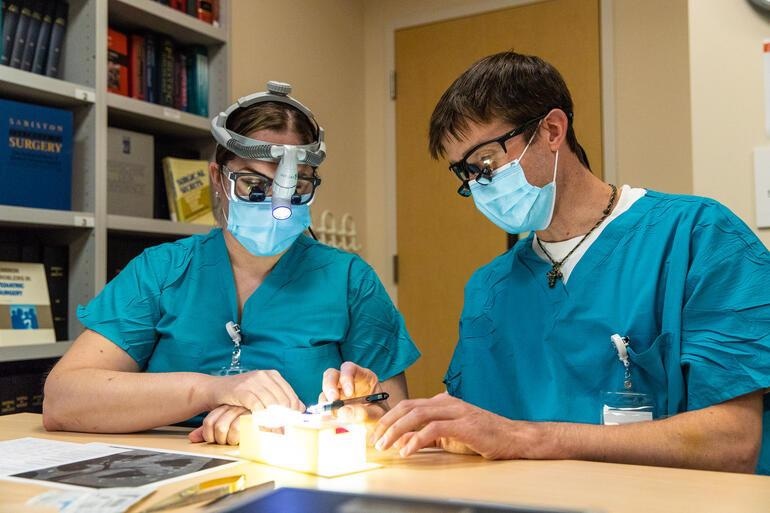
Image Credit: Seattle Children's Hospital
3D Printing is revolutionizing the world of medicine and one hospital in particular is making it a vital part of the life-saving procedures it performs.
From allowing manned space missions to print equipment as and when needed, to simple household repair and the world of gaming, 3D printing has a marked positive effect on our lives. Yet, there is one clear aspect of the human experience in which 3D printing's impact is poised to be immeasurable — medicine.
Researchers are already developing techniques to 3D print artificial limbs, implants and even organs for patients. Clearly, it won't be long before this manufacturing technique makes the jump from improving our lives to saving them.
From both the training of new surgeons to the planning of operations by seasoned doctors, 3D printing is already making surgical medical intervention easier and safer¹. And at the forefront of this transformation is the 3D printing company Stratasys.
The company, founded in 1989 by husband and wife duo Scott and Lisa Crump in Minnesota, is working with academic medical centers to use novel 3D printed hearts to train students. Not only does replacing cadavers with artificial alternatives cut costs — faux organs can be stored at room temperature for example — but these replacements can be designed with specific disorders in mind.
This gives these medical academies the opportunity to train surgeons and doctors on specific illnesses and disorders without waiting for a cadaver to become available. These organs can also be manufactured in situ, cutting out the need for transportation.
Using 3D Printers to Treat Complex Heart Conditions at Seattle Children's
From Training to Planning, to Doing
As this technology becomes more widespread, the time is approaching when doctors can simply request a 'made to order' 3D printed model of an area of the body, a type of tissue, or an organ, to plan surgeries as easily as they order a CT scan.
This can assist in preparation for a surgical procedure with the printed models built so that they can replicate the softness and texture of actual tissue and any individual 'quirks' in that area unique to that particular patient. That means a team of surgeons can plan a procedure with an individualized model of the specific area of the body they are working on.
This practice is already providing vital and potentially life-saving planning that can be applied to treat the most precious and delicate lives.
The 3D printing training technique pioneered by Stratasys is being used at Seattle Children's Hospital to help infants born with pulmonary defects. This approach proves to be of particular importance when dealing with the tiny airways that lead to an infant's lungs.
The hospital's surgical director of the aerodigestive program, Dr. Kaalan Johnson, recently spoke about a case in which this approach was of vital importance, proving that it is already saving lives.
Nia, a child born with bronchial stenosis — the narrowing of her right lung causing breathing difficulty — was treated by surgeons at the hospital when the condition got so bad that it began to cause air to be trapped in her right lung. Johnson says the situation actually became so severe that the swelling of this lung caused the child's heart to be shifted to the left.
In addition to allowing the team of surgeons to plan and practice the procedure in the weeks preceding it, the team could also use the 3D model on the day of the operation. The surgeons employed the model as a reference during the procedure, allowing them to see the area in 'real life' as they worked on it.
Thus, by acting as an anatomical reference, these 3D printed models can allow surgeons to observe actual anatomy and vitally visualize any elements they encounter which are abnormal.
Using 3D Printing to Reassure Patients and their Families
There is also a less practical but no less important use for these models. Surgeons and doctors can use them to explain procedures to both patients and their families. This can give comfort to relatives, assuring them of the surgeons' knowledge and allowing them to better understand the medical interventions being discussed.
Johnson emphasizes this by explaining that Nia's mother took away the 3D model used to help treat her child from the hospital in her purse.
She’s found it valuable anytime someone asks her a question about Nia and what she’s been through, to not only explain her surgery to other people but also to have a clear understanding and reminder herself of what Nia was dealing with and what she went through for the surgery.
Dr. Kaalan Johnson, Surgical Director of the Aerodigestive Program, Seattle Children's Hospital
References
1. Rath. S. N., Sankar. S., [2017], ‘3D printers for surgical practice,’ 3D Printing in Medicine, [https://doi.org/10.1016/B978-0-08-100717-4.00009-0]
Disclaimer: The views expressed here are those of the author expressed in their private capacity and do not necessarily represent the views of AZoM.com Limited T/A AZoNetwork the owner and operator of this website. This disclaimer forms part of the Terms and conditions of use of this website.